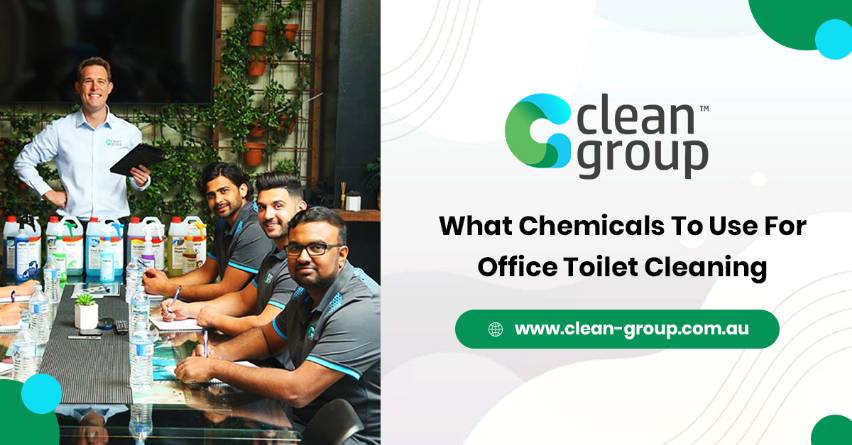If you work in an office setting, your toilet is probably one of the most used areas. With that comes a lot of responsibility in office cleaning services for keeping it clean and sanitary.
For many companies, this responsibility falls on you to make sure things are done right! But how do you know what chemicals to use?
This blog post will break down all the different chemicals and their uses so that next time someone walks up to you with a question about cleaning toilets in the office; you’ll be able to answer them confidently.
Why It’s Important to Clean Your Toilet
Your toilet is one of the first things people see when they walk into your office. But, if it’s starting to look dirty, it might give them a bad impression!
Even if you don’t go into other business areas, cleaning the bathroom is essential because it’s used for more than just office purposes. For example, some businesses require employees to use the bathroom before and after their shift so a dirty toilet can lead to a lot of lost work time.
You also must consider the health risks! For example, a dirty bathroom can have bacteria and fungus inside. In high-risk areas such as hospitals, you shouldn’t be cleaning with just any chemicals. You don’t want to risk spreading something like that around.
How to Choose the Correct Toilet Cleaner
Before we go any further, you should know that it is important to use the chemicals specified for your toilet by either the manufacturer or a professional office toilet cleaner.
This way, you avoid any potentially hazardous reactions and allow yourself time to work with the products without the risk of accidents occurring.
Many chemical combinations can be used for cleaning, but they should be left to professionals. They can also be dangerous if they are not used correctly, which is why you should let the pros handle them.
When it comes to the actual chemicals, many of these facility cleaners use bleach as a disinfectant. This solution will kill 99.9% of bacteria and viruses on contact, so this is a great product to use if your office has an issue with germs.
The Toilet Cleaners
Toilet cleaners that contain bleach should be used in a well-ventilated area, preferably outdoors, because of its harsh fumes. In addition, such chemicals can damage the finish if left on for too long and should be rinsed thoroughly before someone comes back into the building or gets near it.
Therefore many office buildings have different chemicals for the toilets to protect everyone from dangerous fumes or harsh damage.
When looking at a toilet cleaner, it is best to look for a clear and colourless one. The colour comes from dyes, so it’s a good idea to avoid any cleaners with colourful hues as they can stain surfaces if left on too long.
It is also important to note that if the label says it has “disinfectant properties,” this is code for “bleach.” The packaging will not say bleach, so do your best to look for the chemical name instead.
When deciding which cleaning chemicals to use, you should decide how often you want to clean your toilets and purchase chemicals accordingly.
If you have many people using the toilet, you should use a stronger cleaner to combat the germs. However, if you have only a few employees using it, then a milder chemical would suffice.
Another thing to consider when buying cleaning chemicals is how easy it will be for your team members to grab and clean the office toilets. Some chemicals are too heavy or bulky to use and will need to be purchased in smaller bottles.
Toilet Cleaning Supplies [Toilet Cleaning Materials List]
You should keep several different chemicals on your office supplies list, what they’re used for, and where. Here’s a quick rundown of the most common ones:
General Purpose Toilet Cleaner
This is your all-purpose chemical for cleaning the toilet, and it should be used in a well-ventilated area. This solution can be used on any surface to kill bacteria and germs and remove stains. In addition, it leaves behind a fresh scent to leave your bathroom smelling nice.
When using this chemical, always put it in a bucket and rinse after cleaning to avoid residue buildup.
Toilet Bowl Cleaner
This chemical is used specifically for the inside of the toilet bowl. The nozzle has a shape that allows it to fit into hard-to-reach areas and scrub away anything stuck in there, like rust or grime. Make sure the nozzle is submerged in the bowl before squeezing because this will reduce how much chemical gets on your hands.
After you’re finished, put the cap back on and rinse the bathroom for any remaining residue that could cause staining.
Antibacterial Toilet Seat Covers & Cross-Contamination Supplies
This is just a cover you place on the toilet seat to be easily sanitized between each use.
When you buy your cover, make sure to purchase disposable ones because they will biodegrade faster. The chemicals used for cleaning will eventually break down the material, so it’s best to avoid anything that can’t be recycled or reused.
Also, keep in mind that such covers will add a slightly slippery surface to the seat, so it’s best not to use them when you have an elderly or disabled employee using the bathroom.
Toilet Brush
This is a must-have for any cleaning supply list because it is one of the most difficult jobs to do. Cleaning the toilet bowl and inside the tank can be quite time-consuming and, even with chemicals, can take several attempts to get clean.
You should keep in mind that if you use a brush with bristles, make sure to change it every 1 to 3 months. If the same brush is used too often, it can scratch and damage surfaces inside your toilet, which could attract bacteria and germs.
Stocking up on cleaning supplies will help keep employees healthy by protecting them from harsh chemicals and dangerous fumes.
Toilet Bowl Cleaner Tablets
Toilet bowl cleaners are a great alternative to liquid cleaners. You can simply drop one into the tank and let it sit overnight while you sleep. Then, in the morning, flush the toilet and enjoy a fresh-smelling bathroom.
Use A Cleaning Solution That Kills Bacteria
Bleach is a very popular office toilet cleaning chemical for the toilet and for good reasons. It is cheap, easy to use, and will kill 99% of germs when used correctly.
If you don’t want to add chlorine bleach to your cleaning supply list, consider an alternative like vinegar. It works just as well but without harsh fumes.
Clean all the bathroom surfaces and stubborn stains using cleaners specific to that area. Once everything is clean, follow the steps to sanitize it all before you head home.
Tough stains and rust stains can be a pain to get rid of. Consider cutting a lemon in half and scrubbing the stain with it to eliminate any rust particles stuck in the creases or hard-to-reach areas.
Let The Chemical Do the Work
For many of the chemicals you use, simply putting the solution on and waiting a period is all it takes to get rid of tough stains and leave behind a fresh scent.
Always wear the proper personal protective equipment and have clean paper towels, sponges, or other materials on hand to clean up messes.
Last Thoughts
You now know how to clean your office toilet. Maybe you’ve even cleaned it before! If not, give these tips a try and see what happens.
It may take some trial and error, but eventually, you will find the best way for you to keep your bathroom sparkling clean without breaking the bank on expensive supplies or struggling with harsh chemicals that are bad for both humans and the planet.
Do You Need to Hire an Office Cleaning Service?
We can help! Clean Group is the best choice for your business. Our office kitchen washing service is affordable, and we’ll work with you to make sure our service meets your needs. Plus, we have over ten years of experience in the industry, so you know that we do it right when it comes to commercial cleaning.
Let us take care of all your office toilet cleaning needs so that you can focus on running your business instead of worrying about how dirty everything has gotten behind closed doors.
You won’t find another company as experienced or reliable as ours, so let us clean up for good!

